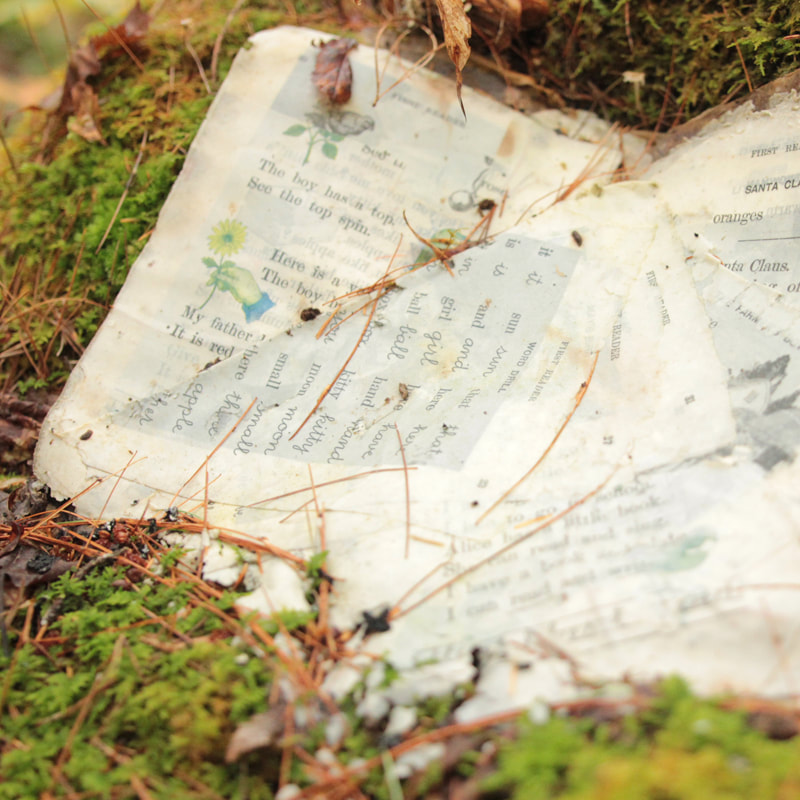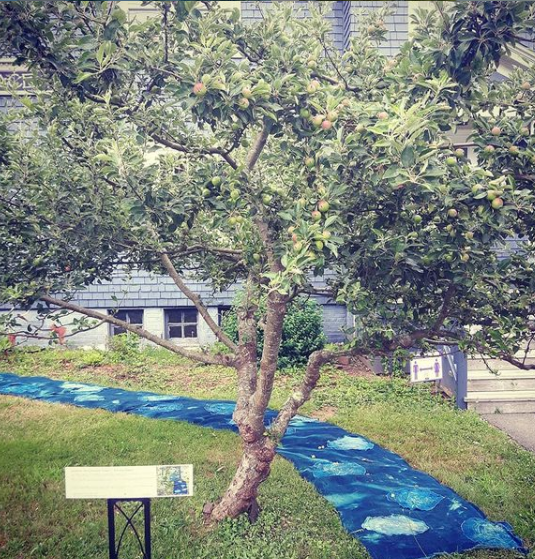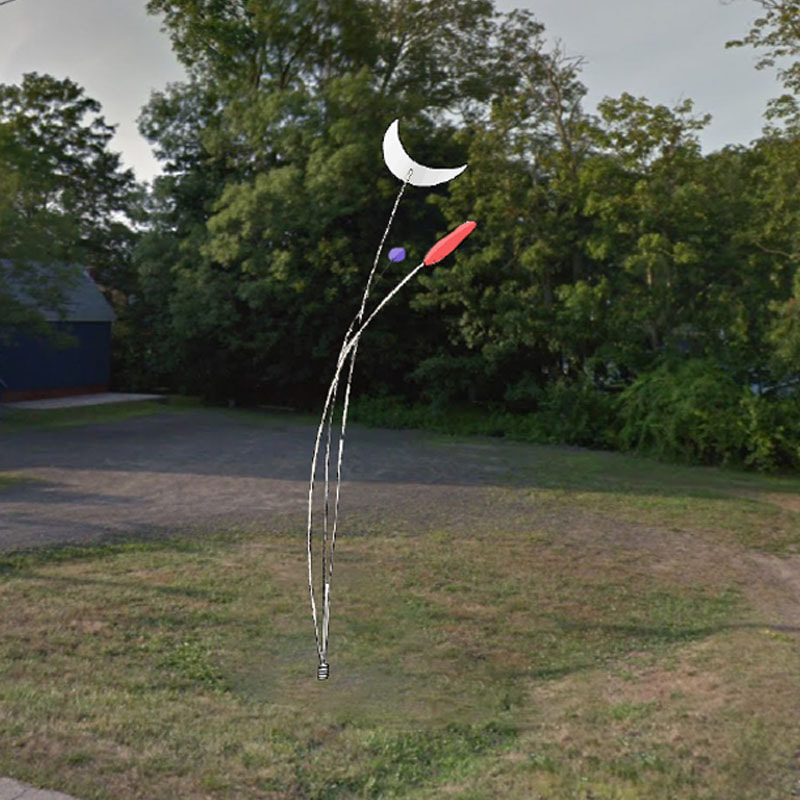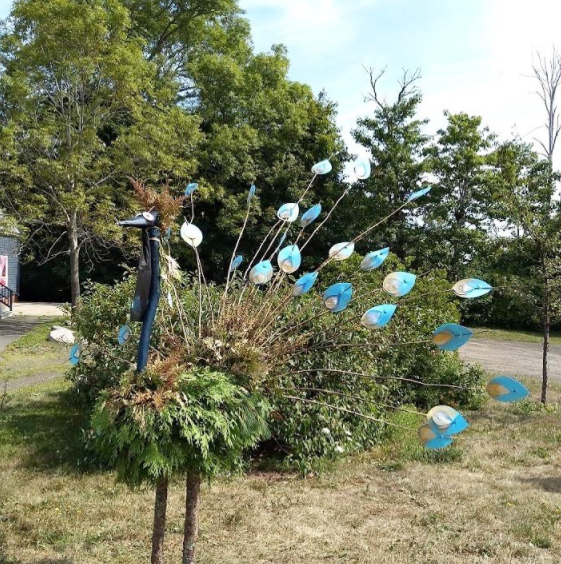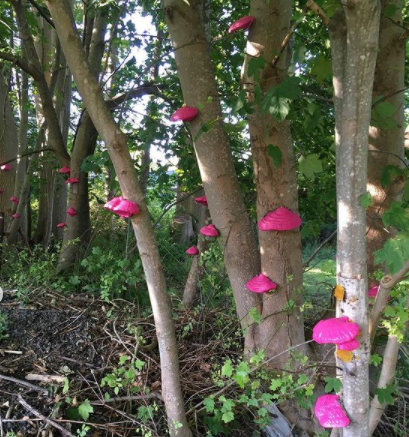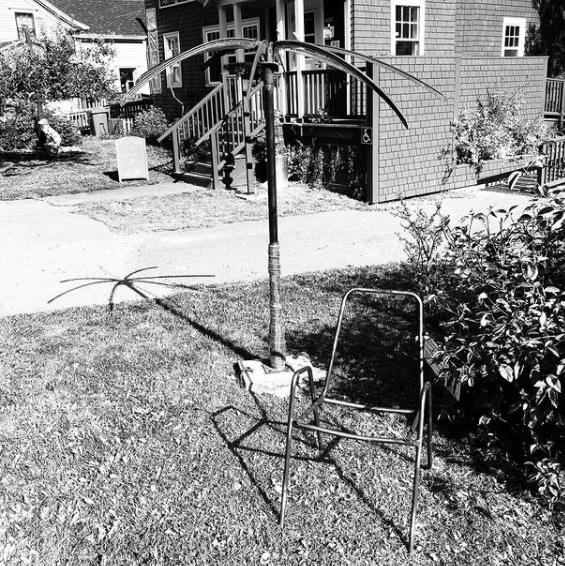Open Space 2020
ARTSPLACE is excited to pilot an outdoor installation program from July - October 2020.
Artists: Karen Langlois, Bonnie Baker, Ben Mosher, Twila Robar-DeCoste, Brandt Eisner, Alexa Jaffurs
#openspace_AP
Artists: Karen Langlois, Bonnie Baker, Ben Mosher, Twila Robar-DeCoste, Brandt Eisner, Alexa Jaffurs
#openspace_AP
July 13 - August 5 Karen Langlois & Bonnie Baker
|
decomposing // Karen Langlois
Vintage books that were intercepted on their way to the landfill are given a temporary place of honour and allowed to integrate organically into the earth. Decomposing expresses an emotional and nostalgic attachment to books as objects. At the same time, it explores the human tendency to cling to the stories that shaped our beliefs and sense of identity. Allowing the books in this installation to decompose is a recognition of the need to respectfully let go of stories that no longer serve us or our community. As nature alters these books, it asserts its ultimate power. Decomposing is an acknowledgement of the need to integrate the earth into the new stories that we tell. Artist Statement My art practice is interdisciplinary, with a focus on constructions and installation. I am drawn to materials with a sense of tactility and suggestion of history. In my work, found books and textiles embody personal and cultural narratives. The process of altering them reflects my experience of the way those narratives can change throughout a lifetime and from one generation to the next. Bio Karen Langlois is an interdisciplinary artist whose practice includes constructions, installation, book objects, collage, mixed media drawing, printmaking and participatory art. A key focus is working with timeworn books and textiles using hand assembly processes, particularly stitching. Langlois lives and works in L’ketuk, Mi’kma’ki (Port Medway, Nova Scotia). Her 2018 exhibition, decomposing: History of England in L’ketuk, at ARTsPLACE in Annapolis Royal was an exploration of her identity as a settler in the unceded territory of the Mi’kmaq. |
Leylines for Ghosted Trees // Bonnie Baker
Leylines for Ghosted Trees is a textile piece created in 2018 for Uncommon Common Art. This work was shown only once in a remote location in a pocket of old growth forest in Wolfville Watershed Nature Reserve. (see images) Six lengths of burlap, 36 '' wide by 9ft long each, had been saturated with cyanotype solution but not exposed to sunlight. Appliques of life size tree rings were sewn onto the burlap in a random pattern. At the site, the burlap lengths were laid end to end as a 58ft strip down a hillside, and exposed to the elements after being covered with leaves, and branches. Over 5 months, the cyanotype process completed on the cloth until the landscape had been imprinted upon it. The installation focuses on visual representation of the transformations of organic forms found in woodlands. By capturing the marks left behind by organic materials, the cloth functioned as residue of the physical inscription of place. Artist statement My work often refers to rural culture and the natural environment in flux. I am fascinated with how we understand environmental forces and how we so often perceive the changing ecology of a landform only in terms of our immediate footprint upon it. To make a mark is a fundamental act in the process of design. It is the primary gesture for making, and representing. It is through the mark that I am able to to generate ideas, explore possibilities of my decisions and seek an understanding of the environment I live in. I use the cyanotype process much like I use a pencil for making a mark, as a way to preserve and chronicle selected objects as an afterthought of themselves. Bio Bonnie is a visual artist based in Nova Scotia. Her work currently focuses on the role of rural identity in transition as related to land usage and domestic traditions using the cyanotype process, installation, drawing and printmaking. A founding member of a community printmaking studio, Bonnie believes community engagement, mentoring and teaching is integral to creative growth. Her work has been exhibited across Canada, US, Europe and collected by Art Bank of NS, and Royal Bank of Canada. She was recognized an Established Artist in Nova Scotia by her peers in 2016. |
August 8 - September 2 Ben Mosher & Twila Robar-DeCoste
|
Trio // Ben Mosher
Trio is a playful wooden sculpture that moves and sways in breezes and gusts. With this work, I am seeking to deepen the experience of wind as it flows through space. By heightening awareness of invisible forces there is a possibility to gain a new sense of wonderment. In a state of wonder, any embrace of the complexities of interactions and reactions that form our everyday environment becomes more available. Trio is about balance and equilibrium, as the force of the wind blows and breaks, each spire of the sculpture reciprocate modulations of the wind with action in an improvised dance. In light breezes, only the tallest spire will sway. When the wind strengthens, all three of the weighted spires begin to rustle and sway. Artist Statement Much of my current work uses common materials, fabrics and papers in bright colours, cut and printed with graphic forms. Stars and clouds criss-cross with matter hanging in limbo and hopping through dark skies into the blue. Quick cartoonish representations mingle with the fuzzy and elusive. I repeatedly doodle these light-hearted graphics until they become instinctive, condensing into an interpretation of things in the world. I try to keep a fresh hand-drawn characteristic to convey these forms. That said, my drawings and prints of simple, seemingly trivial graphic forms can become tried up in social upending of the relationship between heroic and trivial sculpture — questioning binary relationships of strength. The immediate conditions I find myself in always affect what I make. I respond like water and flour, picking up wild yeasts floating precariously in the air, coalescing in a distinct palate of influences. Drifting, as a cloud accumulating dust and pollen in updrafts from below, I collect available nimble materials that become recomposed and delivered into new moderately humorous, playfully exaggerated and entirely of 1 6 flexible forms. I gravitate to materials that are subtle and light, and I am cautious and mindful of my influence on them. I look for ways to keep materials unfixed, allowing them to bounce and sway as a form of subtle performativity. Bio B Mosher creates lighthearted drawing and sculptural works, efficiently pulling from mistakes in their everyday endeavours and attempts to understand their surrounding. As a self-diagnosed dyslexic, they embrace the idiosyncrasies of their flubs while examining and upsetting ideas of ‘simple’ and ‘stupid’. |
Peacock // Twila Robar-DeCoste
The intention of my installation is to bring a bit of joy to those who see it. My bird and animal constructions have a bit of humour and attitude about them and they are meant to bring a smile to the viewer. Artist's statement Twila's work is inspired by the beauty and diversity of nature. She works in watercolour, acrylic, oils and pen and ink to create realistic and detailed painting of birds, botanical subjects, landscapes, and seascapes. She loves to create sculptured creatures and birds from twigs, wood and found materials, using the cast offs of nature to bring a bit of extra joy. It is her hope that her work will encourage a greater respect for our natural environment. Bio Twila Robar-DeCoste, SCA of Aylesford, Nova Scotia is an artist and illustrator, living and working in Nova Scotia’s beautiful Annapolis Valley. She holds BSc., MSc., and B Ed., degrees from Acadia University. Inspired by the beauty and diversity of nature, she works in watercolour, acrylic and pen and ink to create realistic paintings of flowers, birds, landscapes, and seascapes. Ms. Robar-DeCoste has illustrated eighteen books, mostly on natural history for children and adults. She has co-authored two books on local history. She has taught painting classes and workshops since 1987 both in her home studio, and Acadia University. |
September 5 - 30 Brandt Eisner & Alexa Jaffurs
|
Fagus Polyporaceae // Brandt Eisner 2020
“Blue is for boys, pink is for girls”, is the old adage that much of my work uses as a starting point, to challenge basic social constructs around identity. This installation is a reminder of the queer boys and men living in rural areas, who historically just could not fit into their environment and suffered in silence; a reminder of lives lived in fear and hiding; a reminder of those who did not survive, primarily because of who they were. It is indeed a reminder, that in 2020 there are boys still living in fear and men still living secret lives, all to avoid judgement. However, this work is also a celebration of those who came out of hiding in order to blaze a new trail, those who are unapologetically proud today, and those who continuously work on educating the public while supporting and uplifting those who don’t identify as “straight”. I, like so many who grew up in small communities, was bullied and targeted. I wanted to disappear, but like pink fungus, I stood out like a sore thumb in my environment. Only those who have grown up or lived in rural Nova Scotia could really understand what it’s like. Even today, kids raised in the city cannot comprehend how different the world can be just a short drive away. Progress is happening, but for those living in small, often religious communities, it isn’t happening fast enough. Artist Statement My work, primarily sculptural, predominantly speaks to the queer male experience. Although autobiographical in nature, my work covers the common experience of many queer men, especially those who grew up in a rural setting. Despite the social and political progress the queer community has seen over the past ten years, it has become clear that with the current political climate, there is still much work to do in regards to education, tolerance and acceptance. When we broaden this under the context of the global queer experience, it is even more important to remember how so many individuals struggle to navigate an intolerant world, and how many don’t make it out alive. The journey the viewer takes while experiencing my work is a reminder of how subtle experiences at an early age can impact and shape who we are. There are unnoticed emotional and mental scars that queer men carry throughout their lives, which have a great impact on their relationships and social interactions. It is a reminder of how perceived “little things” can shape a person, and thus society. My work reminds the queer community that not all of us have it so good. Boys growing up in rural areas, especially those in fundamentalist religious communities or households, have a very different experience, and are often forgotten by those whose experience is based in the often liberal setting of an urban centre. I also hope that my work acts as an educational tool for the “straight” community. I am so grateful to have had conversations at my show openings, or at artist talks, which may never have otherwise happened: with ‘straight’ fathers who realized that their words can make a huge impact on their sons and that their actions inform their sons about what love looks like, and that not all boys can or want to fall into perceived masculine stereotypes. I believe that for those who are not queer, my work reflects the experience of “otherness” that all of us can experience. No one is immune to the struggles of hyper-masculinity, bullying, the impact of dogmatic religion, body issues, injustice, expectations, exclusion, unhealthy family interactions, or simply not fitting in. In many ways, we have all experienced being “the other” at some point, especially in our younger years. It is important to me that my work speaks to these experiences. I want the viewer to bring their own history to my work for it is as valid as mine. I don’t want my work to be isolating and exclude the commonality we all share, despite our age, gender, skin colour or sexual identity. Bio Growing up in a small community on the South Shore of Nova Scotia, I began creating assemblages as a way to express myself, not only as "art for art's sake", but also as a form of self-therapy. Fortunately, I was welcomed into the local art community, whose encouragement motivated me to continue to produce and show my work, as well as to get involved in community events such as serving on the Board for the South Shore Festival of the Arts, and organizing art and craft shows. After graduating from NSCAD in 2005, I began working at Argyle Fine Art in Halifax, N.S. and became the Assistant Director. After five years at Argyle, in 2010, I opened Swoon - Fine Art and Antiques on Hammonds Plains Road, just outside Halifax NS. Although a life changing experience, in 2015, I closed Swoon's brick and mortar location. Today I currently curate and assist with local art shows, but am mostly focused on my own art practice. |
Habitat for a Brave New World // Alexa Jaffurs 2020
Nova Scotia forests are being clearcut at an alarming rate. Rather than whine about the loss of important habitat for threatened species, why not view this as an opportunity to create prototypes for the new age that is coming? Artist-blacksmiths are in a unique position to help create replacement trees. Metal trees are fire-proof, drought resistant, store as much carbon and support as much wild life as a clearcut. The pieces might stand in for the missing trees/ missing forests in our landscape. Simple in form with surface effects that either hearken back to their dead ancestors or look forward to offering shelter for newly evolved species more fit to live in the environment we are creating. These are not metal replicas of organic trees but abstracted ideas of the various functions the original trees might have offered. Despite the deep despair I feel for our natural world, I hope the objects themselves will evoke smiles as well as second thoughts about how trees fit in our world. Artist Statement Between hammer and anvil. I love the way that metal can be stretched and squashed and bent and twisted, the marvelous and varied forms it can take when heated and forged. In my work, I strive for a graceful organic flow and sensuous surfaces. Simplicity is good. I want to see symmetry where it is a mark of good craftsmanship. Elsewhere, I don't insist on strict obedience. A finished piece should seem like a living thing that has paused ever so briefly under your watchful gaze. Bio Alexa began blacksmithing in Florida in 1980. Banging on metal proved to be the perfect counterpoint to her career as a librarian. She has been moving her scrap pile northward ever since. Initially she produced small abstract sculptures for interiors. When she established Ladysmith Forge in Connecticut in 1991, she learned to make hardware suitable for 18th and 19th century buildings. In 2006, she immigrated to Canada. Today, she and her wife live on a 125 acre farm in Mt. Hanley, Nova Scotia. Alexa forges garden sculpture and private commissions under the watchful eyes of a small flock of sheep. Her work can be seen at the Tangled Garden in Grand Pré and occasionally at the Annapolis Royal Historical Garden and, virtually, on her website: AlexaJaffurs.com |

